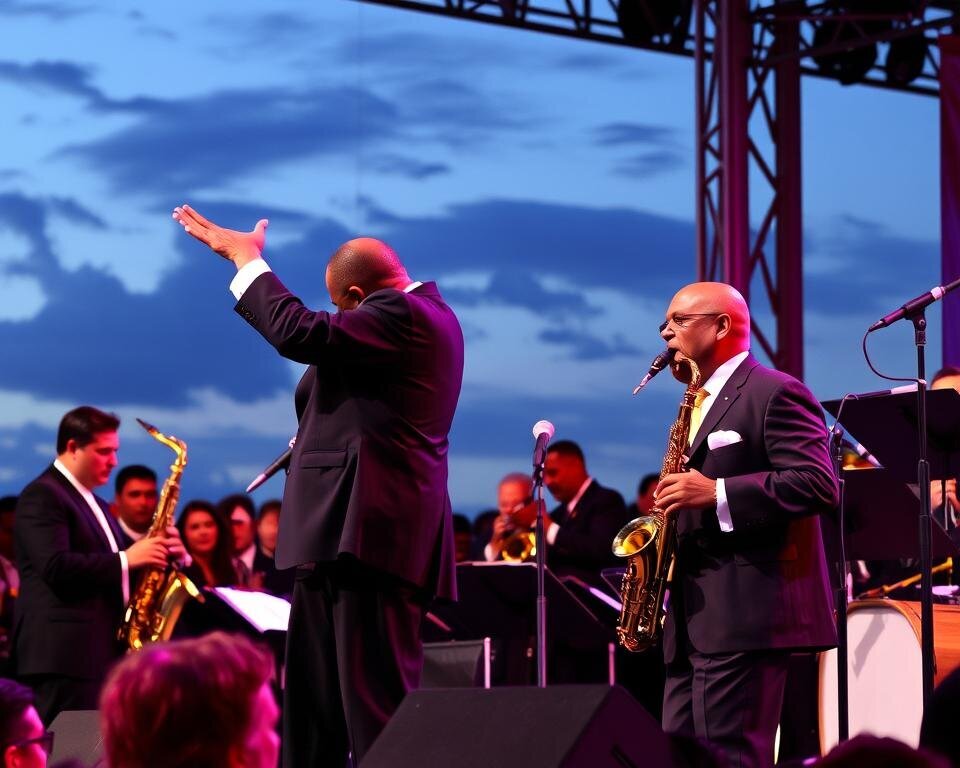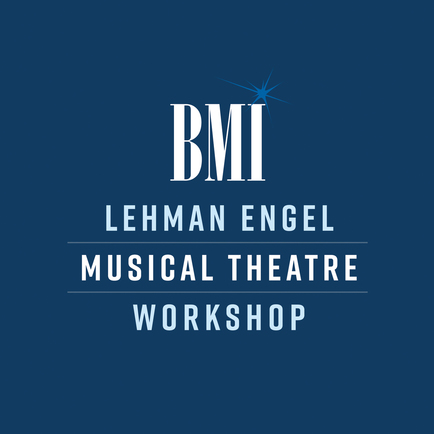Duke Ellington is a jazz legend with a career spanning over 50 years. Born on April 29, 1899, in Washington, D.C., he changed jazz forever. His unique vision and big-band jazz innovations left a lasting impact.
Ellington was a master pianist, composer, and bandleader. He wrote thousands of scores, creating a sound that influenced many. His orchestra, led from 1923 until his death in 1974, featured over 500 talented musicians.
Ellington’s music touched many genres, from “It Don’t Mean a Thing (If It Ain’t Got That Swing)” to “Sophisticated Lady” and “Solitude.” His skill in blending sounds and textures made him a jazz innovator.
Early Life and Influences
Duke Ellington, the famous jazz legend, was born in 1899 in Washington, D.C. He came from a middle-class family. His family supported his love for the arts, and he started piano lessons at seven.
Ellington was inspired by ragtime performers. He began his music career at 17.
Childhood and Education
Ellington’s father was a butler who wanted him to be an artist. The family expected their children to act with class. Ellington learned to read music early, which helped him in his music career.
Musical Beginnings
As a teenager, Ellington’s love for music grew. He was drawn to ragtime, which was popular in Washington, D.C.. His talent and early piano studies helped him create his unique style. This set him on the path to becoming a leading jazz musician.
“I merely took the energy it takes to pout and wrote some blues.” – Duke Ellington
Career Milestones
Duke Ellington started his jazz journey in the early 1920s in New York City. In 1923, he led a small group that grew into a 10-piece band. This was the start of the famous Duke Ellington Orchestra.
The band played at the iconic Cotton Club in Harlem from 1927 to 1932, and again from 1937 to 1938. These years were key for Ellington’s career.
As the band grew to 14 musicians, Ellington’s music evolved. He mixed jazz orchestras and Broadway musicals into a unique sound. He chose each musician for their special talents, like Cootie Williams on trumpet and Johnny Hodges on alto saxophone.
The Duke Ellington Orchestra recorded hundreds of songs, appeared in films, and went on their first European tour in 1933. By the late 1930s, they were at the top of their game. They amazed people all over the world with their performances.
Breakthroughs in the 1920s
In the 1920s, Duke Ellington’s band became famous at the Cotton Club in Harlem, New York. They played there from 1927 to 1932, and again from 1937 to 1938. Their mix of jazz and Broadway musicals made them a big hit.
Major Works and Compositions
Duke Ellington was a key figure in American jazz and the swing era. He left a lasting impact on music with his vast collection of works. Classics like “East St. Louis Toodle-oo” (1926), “Mood Indigo” (1930), and “It Don’t Mean a Thing (If It Ain’t Got That Swing)” (1932) are just a few examples. He also created ambitious pieces like “Creole Rhapsody” (1931) and “Black, Brown and Beige” (1943).
Classic Hits and Timeless Pieces
Ellington’s music is still loved today, thanks to his ability to craft unforgettable melodies. His collaboration with Billy Strayhorn on “Satin Doll” in 1953 is a prime example. This song has become a beloved part of the Duke Ellington Orchestra’s repertoire.
Collaborations with Other Musicians
Ellington’s talent wasn’t just in his own music. He also worked with jazz greats like Louis Armstrong, Ella Fitzgerald, and John Coltrane. One notable collaboration was with saxophonist Johnny Hodges. Ellington wrote “I Got It Bad (and That Ain’t Good)” for him, showing his skill in creating music for different artists.
“Duke Ellington was the musical celebrity at the height of the swing era in 1938.”
Ellington’s Unique Style
Duke Ellington was a true jazz innovator. He mixed genres and expanded musical expression. His style was known for a rich sound, new harmonies, and understanding each musician’s talent.
Blending Genres and Innovations
Ellington’s music combined jazz, classical, and world music. This blend broke down old genre lines. His works, like the Liberian Suite (1947) and the Far East Suite (1964), showed his skill in orchestral masterpieces. They mixed jazz innovation with different cultures.
Signature Elements of His Music
Ellington’s music was all about sound and the unique voices of his orchestra. Harry Carney’s deep bass and Cootie Williams’ solos were key. They made his music lively and engaging for fans everywhere.
“Ellington’s music is about sound, not just notes. What he tried to do was to create a sound that expressed the feelings of black people in America – their aspirations, their determination, and their humanity.”
Ellington’s way of using orchestration, harmonies, and musicians’ talents made him a visionary. His work in jazz innovation and more is unmatched.
Impact on Jazz History
Duke Ellington was a key figure in jazz, taking it to new heights. He was a composer, bandleader, and visionary. His work in big-band jazz and the swing era changed jazz forever.
Contributions to Big-Band Jazz
Ellington’s unique style helped big-band jazz grow. He created a talented group and made complex arrangements. His songs, like “Creole Rhapsody” and “Black, Brown and Beige,” showed his skill in blending styles.
Influence on Future Generations
Ellington’s impact went beyond big-band jazz. His musical voice and dedication inspired many. His work shaped jazz history, making him a legend in the 20th century.
“I merely took the energy it takes to pout and used it to play the game of life to win.” – Duke Ellington
Ellington also worked in film, ballet, and theater. He showed jazz’s versatility and importance. His legacy continues to influence big-band jazz today.
Notable Performances
Duke Ellington’s career lasted from the late 1920s until his death in May 1974. He gave many unforgettable performances during this time. His work at the Cotton Club in Harlem during the Harlem Renaissance was especially significant.
There, Ellington and his orchestra wowed audiences with jazz, blues, and orchestral arrangements. They became one of the top big bands of their era.
Years later, Ellington’s fame grew at the Newport Jazz Festival in 1956. His performance, with a famous saxophone solo by Paul Gonsalves, brought the band back into the spotlight. This success led to international jazz tours across the globe, making Ellington a jazz icon worldwide.
“I don’t believe in categories of any kind. I believe in spontaneity and freedom of expression.”
– Duke Ellington
Awards and Honors
Duke Ellington was celebrated for his contributions to American music and culture. He won 14 Grammy Awards, including a Lifetime Achievement Award in 1966. This award honored his unique artistry and musical innovations.
In 1969, Ellington received the Presidential Medal of Freedom. This is the highest civilian honor in the nation. It recognized his deep impact on the arts and his status as a cultural icon.
Grammys and Recognition
Ellington won Grammys throughout his career. His Grammy Lifetime Achievement Award in 1966 made him a jazz legend. It solidified his place among the greatest musicians.
Inductions and Memorials
Ellington was also honored by being inducted into the DownBeat Hall of Fame in 1952. This award celebrated his artistic brilliance and lasting influence on jazz.
In 1999, Ellington received a special Pulitzer Prize for his musical contributions. This award cemented his legacy as a celebrated and influential artist of the 20th century.
“Duke Ellington was beyond category… I know that (he) was a person of royal heritage, and the reference is point-on.” – Quincy Jones
These honors and inductions recognized Ellington’s musical genius and his impact on American culture. They solidified his status as a true jazz icon and a key figure in modern music.
Personal Life
Duke Ellington was not just a musical genius but also had a captivating personal life. In 1918, he married his high school sweetheart, Edna Thompson. Together, they had a son named Mercer Ellington. Even though they later separated, Ellington had many long-term relationships.
Ellington was also a strong advocate for civil rights. He used his music to fight for racial equality, performing at events that challenged segregation. His philanthropy went beyond civil rights, showing his dedication to helping others.
Ellington enjoyed many hobbies, like painting and cooking. He loved baseball too. Despite health issues like high blood pressure and heart problems, he kept performing until his death in 1974 at 75.
“Music is my mistress, and she plays second fiddle to no one.”
Ellington’s love for music and his efforts to make a difference have greatly influenced jazz and beyond.
Legacy and Cultural Significance
Duke Ellington left a lasting mark on jazz history. His legacy is kept alive by institutions and events that honor his work. The Smithsonian Institution holds a vast collection of his music and personal items. This collection is a treasure trove for jazz education and research.
The Duke Ellington Jazz Festival in Washington, D.C., celebrates his life and music. Now in its 22nd year, it brings together vibrant performances and educational programs. It shows how Ellington’s music still captivates audiences today.
Influence on Modern Jazz Artists
Duke Ellington’s unique style has inspired many jazz musicians. He mixed genres like swing and bebop, encouraging improvisation. This approach has pushed the genre forward.
Education programs worldwide, like the Duke Ellington School of the Arts, study his legacy. These programs help grow the next jazz talent. Ellington’s influence keeps jazz evolving.
“Duke Ellington’s music sounds like the place it’s from – New York City. It’s like a city that never sleeps.” – Wynton Marsalis, jazz trumpeter and educator
Critical Reception
Duke Ellington’s work has seen a big change in how it’s viewed over the years. At first, he was loved for his catchy tunes. But as his music got more complex, critics started to see the real depth and artistry in his longer pieces.
Ellington’s sacred concerts, starting in 1965, got mixed reviews. But they showed his wide range as a composer. Over time, Ellington’s status as a musical innovator and cultural icon grew. Many now see him as one of America’s greatest composers, alongside Charles Ives.
Reviews of His Work
Duke Ellington’s music after the war was seen as less successful by many critics. But Terry Teachout’s “Duke: A Life of Duke Ellington” has given a fresh look at his legacy.
The Evolving Perspective on His Music
Ellington’s experiments in extended musical form haven’t gotten as much attention in jazz criticism. There’s also a lack of scholarly biographies and music criticism from trained musicians. This has led to a changing view of his musical innovation and cultural impact.
Despite these challenges, Ellington’s fame as a jazz criticism icon has grown. His music still draws in fans and inspires new artists.
Conclusion
Duke Ellington’s impact on jazz and American music is huge. He wrote over 1,000 songs and led a famous jazz orchestra. His work shows his talent in mixing different music styles and his dedication to excellence.
Ellington helped make jazz a respected art form. His music still excites people all over the world. He is a key figure in 20th-century American music.
Ellington’s Lasting Impact on Music
Ellington’s music has reached across time and genres. His songs are a big part of our culture. Musicians everywhere perform and study his work.
His influence can be seen in many areas of music today. Ellington’s legacy as an American music icon is strong. His music and message continue to inspire and teach us.
Source Links
- Duke Ellington – Songs, Facts & Quotes
- The Duke Of Ellington: The Renaissance Man Of Jazz
- Duke Ellington
- Duke Ellington
- Duke Ellington + Harlem
- Duke Ellington
- Duke Ellington | Songwriters Hall of Fame
- Songbook Hall of Fame Inductee: Duke Ellington
- 10 of the Best Duke Ellington Songs [Stories of a Jazz Legend]
- Duke Ellington
- THE DEVELOPMENT OF DUKE ELLINGTON’S COMPOSITIONAL STYLE: A COMPARATIVE ANALYSIS OF THREE SELECTED WORKS
- Duke Ellington: The Jazz Genius and His Legacy
- How Duke Ellington stretched the boundaries of jazz and classical
- Jazz Appreciation Month: Duke Ellington
- Duke Ellington – The Life & Music of a Jazz Hero
- Duke Ellington: 5 Essential Performances (To Celebrate His 114th Birthday)
- Top 25 Duke Ellington Songs! Know These Duke Ellington Hits
- Duke Ellington | Kennedy Center
- Berklee Legacy Awards Honor Duke Ellington, Sarah Vaughan, Joseph Douglass, and Carmen de Lavallade
- Duke Ellington
- Duke Ellington ~ Duke Ellington biography | American Masters | PBS
- The Legacy of Duke Ellington
- Duke Ellington
- Duke Ellington’s legacy and influence (Chapter 17) – The Cambridge Companion to Duke Ellington
- Big Band (Published 2013)
- (Over)praising Duke Ellington
- “Duke Ellington’s Greatest Hits” reviewed by Jeffrey Leibham – AROUND THE TOWN CHICAGO
- Duke Ellington: Artist of the Century – JazzTimes
- Duke Ellington – Music 345: Race, Identity, and Representation in American Music
- Duke Ellington’s New York Rise















